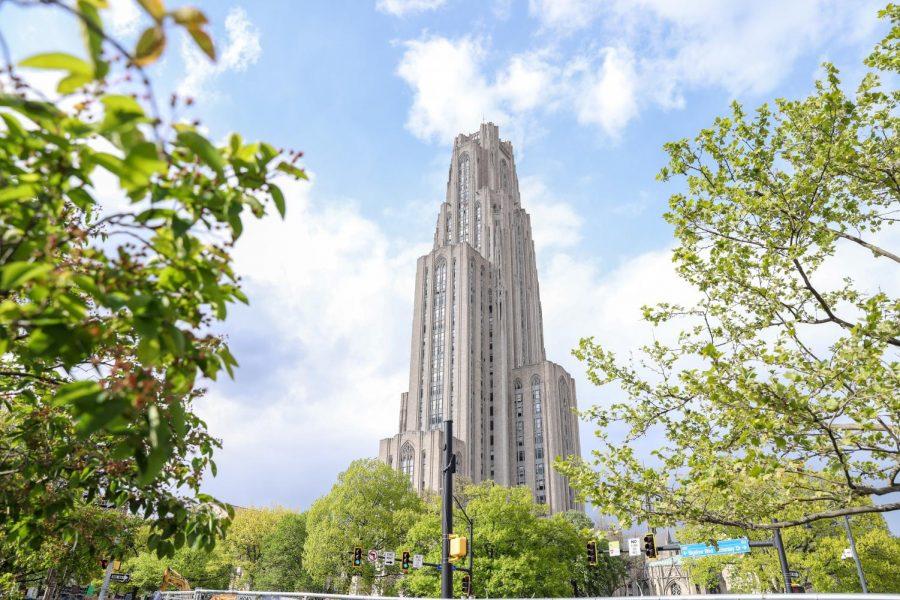Students vote Latin American Revolutions as Pitt best course
Kaycee Orwig | Senior Staff Photographer
The Cathedral of Learning.
March 22, 2022
Anna Kovarick’s family fled Cuba when a 1950s uprising led to the formation of the country’s Communist party. She said this played a key role in her interpretation of her history course, Latin American Revolutions.
“Professor Gobat gave me the opportunity to weave into the course a lot of reflection on my own family’s events and history alongside the more general context of the Cuban revolution, and how it affected the country as a whole, but also a small family that came to the United States because of the revolution,” Kovarick, a senior economics and business administration major, said.
Pitt students voted Latin American Revolutions, a history course taught by Professor Michel Gobat, the best undergraduate course at Pitt in The Pitt News’ 2022 “Best Of” survey..
The course focuses on three Latin American revolutions in the 20th century — the Mexican Revolution, the Cuban Revolution and the Nicaraguan Revolution, according to Gobat. Gobat said the purpose of focusing on only three revolutions is to allow students to develop a deeper understanding of all aspects of the events that impacted the revolutions.
“I want to give students the opportunity to get a more in-depth sense of a country’s history and revolution,” Gobat said. “I use readings, video clips, music, interviews and films to do that.”
Gobat said his approach to teaching the class is different from the typical way revolutions are discussed. It moves away from traditional revolutionary narratives, to instead focus on people and movements who are often forgotten in historical analysis.
“The class tries to get students to think about a variety of actors,” Gobat said. “We look at peasants involved in the Mexican revolution and the role women played in the Nicaraguan revolution. Often when people take courses on revolutions the emphasis is on the origins of the revolution and the outcomes of them, but I’m really interested in what happens during the in-between period.”
Justin Jones, a senior history and Spanish major who took the course last year, said the use of firsthand accounts is something that elevated the class from other ones he has taken.
“I really liked the unit on the Cuban revolution,” Jones said. “We read an anthropological study that was a detailed breakdown of day-to-day life in rural communist Cuba towards the end of the 20th century, and we watched a documentary about the ‘Special Period,’ which was when the Soviet Union collapsed.”
Jones said the interactive classes make Gobat’s course stand out from the thousands that Pitt has to offer.
“Class was split into different groups of four or five students, and we would discuss the out-of-class material with the groups,” Jones said. “Talking about different opinions made the class more lively, and everyone was able to feel like they could safely share their own thoughts.”
Kovarick said she enjoyed the way in which the course was set up, using flip lectures, because in-class time was utilized for discussions, which distinguishes the class from others. She said podcasts created by Gobat were instrumental to her understanding of the course.
“The course combines out-of-class podcasts and readings, and we came into class ready for discussions and group work in order to have the most well-rounded understanding of the material,” Kovarick said. “I had never had podcasts as course material for a class before, and I liked hearing Professor Gobat talk through the historical events and set up the themes we’d be discussing in class.”
Gobat said the course is adaptable, evolving with students in a way that encourages them to incorporate their own interpretations of and opinions on the events discussed in class. This level of open discussion increases everyone’s understanding of historical events, according to Gobat.
“I want my students to develop analytical skills,” Gobat said. “The classes are about getting students to talk, and it was satisfying to see how they talk to each other and work through their thoughts and ideas. When students talk, I learn things. Every time I show the same image I learn something new from them. I want to learn too, and the best way to learn is by letting students talk.”
This level of participation also allows students to focus their assignments and graded work on aspects of the revolutions that they were drawn to, which is something Kovarick said made the class especially enjoyable.
“You could choose the topics that you wanted to write about for the papers assigned through the semester,” Kovarick said. “There were a lot of opportunities to learn and tailor the class to your specific interests.”
Jones said the course takes interesting material and presents it in a way that delves into revolutionary narratives, while continuously engaging students.
“It’s a class that doesn’t bore you,” Jones said. “You’re learning something in a way that lets you actually engage with it. Revolutions have a certain natural romanticism that interests people, and the course acknowledges this, but still grounds the revolutions in reality.”








